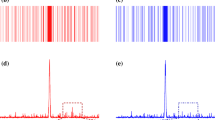Abstract
Compressed Sensing (CS) for the acceleration of MR scans has been widely investigated in the past decade. Lately, considerable progress has been made in achieving similar speed ups in acquiring multi-shell high angular resolution diffusion imaging (MS-HARDI) scans. Existing approaches in this context were primarily concerned with sparse reconstruction of the diffusion MR signal \(S({\mathbf {q}})\) in the \({\mathbf {q}}\)-space. More recently, methods have been developed to apply the compressed sensing framework to the 6-dimensional joint \(({\mathbf {k}},{\mathbf {q}})\)-space, thereby exploiting the redundancy in this 6D space. To guarantee accurate reconstruction from partial MS-HARDI data, the key ingredients of compressed sensing that need to be brought together are: (1) the function to be reconstructed needs to have a sparse representation, and (2) the data for reconstruction ought to be acquired in the dual domain (i.e., incoherent sensing) and (3) the reconstruction process involves a (convex) optimization.
In this paper, we present a novel approach that uses partial Fourier sensing in the 6D space of \(({\mathbf {k}},{\mathbf {q}})\) for the reconstruction of \(P({\mathbf {x}},{\mathbf {r}})\). The distinct feature of our approach is a sparsity model that leverages surfacelets in conjunction with total variation for the joint sparse representation of \(P({\mathbf {x}}, {\mathbf {r}})\). Thus, our method stands to benefit from the practical guarantees for accurate reconstruction from partial \(({\mathbf {k}},{\mathbf {q}})\)-space data. Further, we demonstrate significant savings in acquisition time over diffusion spectral imaging (DSI) which is commonly used as the benchmark for comparisons in reported literature. To demonstrate the benefits of this approach, we present several synthetic and real data examples.
This research was funded in part by the AFOSR FA9550-12-1-0304 and NSF CCF-1018149 grants to Alireza Entezari and the NIH grant NS066340 to Baba C. Vemuri.
Access this chapter
Tax calculation will be finalised at checkout
Purchases are for personal use only
Similar content being viewed by others
References
Callaghan, P.T.: Principles of Nuclear Magnetic Resonance Microscopy. Oxford University Press, Oxford (1991)
Tuch, D.S.: Q-ball imaging. Mag. Res. Med. (MRM) 52, 1358–1372 (2004)
Ugurbil, K., Xu, J., et al.: Pushing spatial and temporal resolution for functional and diffusion MRI in the human connectome project. NeuroImage 80, 80–104 (2013). Mapping the Connectome
Lustig, M., Donoho, D., Pauly, J.: Sparse MRI: the application of compressed sensing for rapid MR imaging. Mag. Res. Med. (MRM) 58, 1182–1195 (2007)
Landman, B.A., Wan, H., Bogovic, J., van Zijl, P., Bazin, P.L., Prince, J.: Accelerated compressed sensing of diffusion-inferred intra-voxel structure through adaptive refinement. In: ISMRM (2010)
Lee, N., Singh, M.: Compressed sensing based DSI. In: ISMRM (2010)
Menzel, M., Khare, K., King, K.F., Tao, X., Hardy, C.J., Marinelli, L.: Accelerated DSI in the human brain using compressed sensing. In: ISMRM (2010)
Merlet, S.L., Deriche, R.: Continuous diffusion signal, EAP and ODF estimation via compressive sensing in diffusion MRI. Med. Image Anal. 17, 556–572 (2013)
Merlet, S., Caruyer, E., Deriche, R.: Parametric dictionary learning for modeling EAP and ODF in diffusion MRI. In: Ayache, N., Delingette, H., Golland, P., Mori, K. (eds.) MICCAI 2012, Part III. LNCS, vol. 7512, pp. 10–17. Springer, Heidelberg (2012)
Michailovich, O.V., Rathi, Y., Dolui, S.: Spatially regularized compressed sensing for high angular resolution diffusion imaging. IEEE Trans. Med. Imaging 30, 1100–1115 (2011)
Mani, M., Jacob, M., Guidon, A., Magnotta, V., Zhong, J.: Acceleration of high angular and spatial resolution diffusion imaging using compressed sensing with multichannel spiral data. Mag. Res. Med. (MRM) 73, 126–138 (2015)
Cheng, J., Shen, D., Yap, P.T.: Joint k-q space compressed sensing for accelerated multi-shell acquisition and reconstruction of the diffusion signal and ensemble average propagator. In: ISMRM, p. 664 (2014)
Donoho, D.: Compressed sensing. IEEE Trans. Inf. Theory 52, 1289–1306 (2006)
Candès, E., Tao, T.: Near-optimal signal recovery from random projections: universal encoding strategies? IEEE Trans. Inf. Theory 52, 5406–5425 (2006)
Do, M.N., Vetterli, M.: Image denoising using orthonormal finite ridgelet transform. In: International Symposium on Optical Science and Technology, pp. 831–842. International Society of Optics and Photonics (2000)
Ying, L., Demanet, L., Candes, E.: 3D discrete curvelet transform. In: Optics & Photonics 2005, pp. 591413–591413. International Society of Optics and Photonics (2005)
Lu, Y.M., Do, M.N.: Multidimensional directional filter banks and surfacelets. IEEE Trans. Image Process. 16, 918–931 (2007)
Xu, X., Sakhaee, E., Entezari, A.: Volumetric data reduction in a compressed sensing framework. Comput. Graph. Forum (CGF) 33, 111–120 (2014). Special Issue on EuroVIS
Goldstein, T., Osher, S.: The split bregman method for l1-regularized problems. SIAM J. Imaging Sci. 2, 323–343 (2009)
Willett, R.M.: Smooth sampling trajectories for sparse recovery in MRI. In: Proceedings of the 8th International Symposium on Biomedical Imaging, ISBI 2011, Chicago, Illinois, USA, pp. 1044–1047, 30 March – 2 April 2011
Author information
Authors and Affiliations
Corresponding author
Editor information
Editors and Affiliations
Rights and permissions
Copyright information
© 2015 Springer International Publishing Switzerland
About this paper
Cite this paper
Sun, J., Sakhaee, E., Entezari, A., Vemuri, B.C. (2015). Leveraging EAP-Sparsity for Compressed Sensing of MS-HARDI in \(({\mathbf {k}},{\mathbf {q}})\)-Space. In: Ourselin, S., Alexander, D., Westin, CF., Cardoso, M. (eds) Information Processing in Medical Imaging. IPMI 2015. Lecture Notes in Computer Science(), vol 9123. Springer, Cham. https://doi.org/10.1007/978-3-319-19992-4_29
Download citation
DOI: https://doi.org/10.1007/978-3-319-19992-4_29
Published:
Publisher Name: Springer, Cham
Print ISBN: 978-3-319-19991-7
Online ISBN: 978-3-319-19992-4
eBook Packages: Computer ScienceComputer Science (R0)




